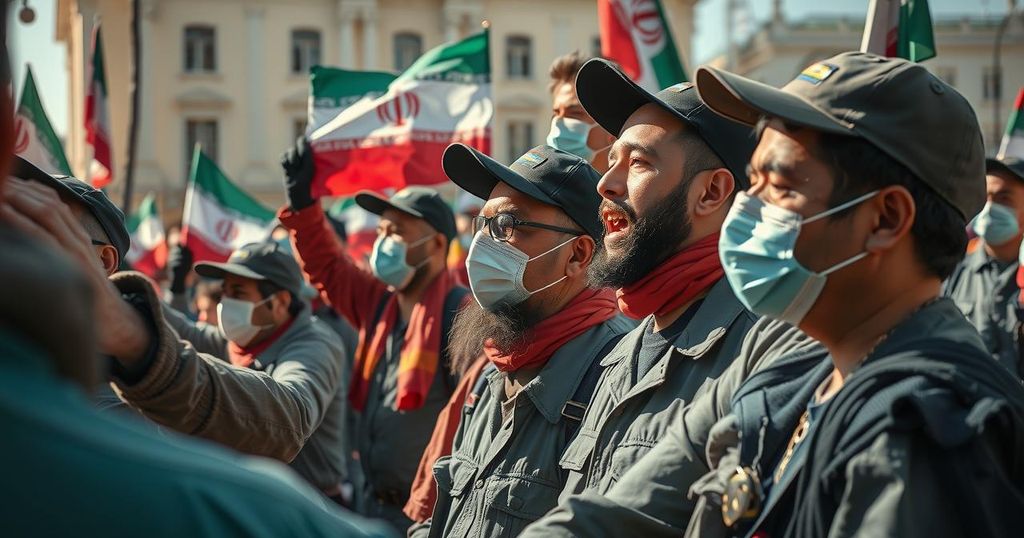On January 13, Iranian labor organizations and retirees condemned the regime’s anti-labor policies, highlighting inadequate wage adjustments against soaring living costs. Activists argue that the government’s flawed calculations exacerbate economic hardships, calling for unity among marginalized groups. As protests increase, the regime’s oppressive tactics have failed to quell dissent, intensifying demands for reform and workers’ rights amidst worsening economic conditions.
On January 13, a coalition of labor organizations and retirees in Iran issued a poignant statement expressing their condemnation of the Iranian government’s anti-labor policies, which they assert have increasingly alienated workers and wage earners throughout the nation. Citing the government’s incorrect and detrimental policies, the coalition warned of deteriorating conditions and an impending crisis within the working class. Signatories included the Haftapeh Sugar Cane Workers Union, the Retired Union Group, and the Coordinating Committee to Help Establish Labor Organizations, alongside several retirees from Khuzestan Province. They emphasized the essential role of the working class as the principal contributors to the nation’s wealth, stating, “the wheels of the economy move with this labor power.”
Criticism was directed primarily at the government’s wage policies, which the labor organizations described as deteriorating compared to previous years. They cautioned that the continued suppression of wages would exacerbate the situation, pushing society to a precarious state. The organizations maintained that workers’ wages should align with the living expenses necessary for an average urban family, as stipulated by Article 41 of Iran’s Labor Law. This law mandates that minimum wage calculations must reflect inflation and the current cost of living.
Activists assert that the government’s official wage calculations are significantly misleading. While statistics indicate that the cost of living in larger cities ranges from 32 to 37 million tomans, the coalition argues that in reality, the necessary amount for a family of four in 2024 is closer to 40 to 45 million tomans. In stark contrast, the mandated minimum wage for workers with dependents stands at a mere 11 million tomans, with many earning even lower amounts.
Amidst consistent inflation and surging housing costs, Omid Nasibi, a member of Parliament’s Councils and Internal Affairs Commission, remarked, “In the current inflationary conditions, the working class is unable to meet the cost of housing rent and livelihood. They are facing serious problems.” Despite a recently announced 20% salary increase for government employees and expectations of an up to 30% increase for workers, these adjustments remain inadequate. Projections suggest that living costs could escalate to 55 to 60 million tomans by 2025, further straining workers and their families.
Workers in Iran are reported to receive some of the lowest wages in the region, a fact that, combined with rampant inflation and rising living expenses, places immense pressure on the labor force. The coalition’s statement pointed out the regime’s failure to address these issues, noting that its policies have eroded support from workers and wage earners alike. They called for solidarity among all oppressed groups, including teachers, retirees, youth, women, farmers, and health workers, to challenge the government’s detrimental policies.
Recent years have witnessed escalating protests among workers, educators, pensioners, and other wage earners who frequently voice their grievances against the regime’s economic and labor policies, advocating for fair wages and improved working conditions. Despite increasing unrest, the government has responded with security measures aimed at stifling dissent. Nevertheless, labor and social activists believe these oppressive tactics have not been successful in suppressing workers’ frustrations.
As Iran’s economic crises deepen, the working class and various marginalized groups are organizing to demand their rights. The joint statement from labor organizations serves as an urgent call for collective action, alerting that without substantial reforms, the social and economic fabric of the country will continue to deteriorate. The disparity between living costs and wage adjustments, coupled with persisting inflation, adds pressure on the regime from the vital labor force that sustains the economy. The ongoing protests by workers and other groups highlight the pressing economic hardships and serve as a critical indictment of policies that have continuously hindered the working class’s survival.
Iran has witnessed a series of labor disputes driven by the deteriorating economic conditions facing workers and retirees. High inflation rates, coupled with insufficient wage growth, have led to widespread dissatisfaction among the labor force. This unrest is a response to policies perceived as anti-labor, prompting collective declarations from various labor organizations and community representatives. Understanding the economic context—particularly the challenges related to the cost of living—illustrates the urgency behind these protests and condemnations of the Iranian regime’s approach to labor relations.
The joint statement from labor organizations in Iran underscores the critical situation faced by workers and retirees due to anti-labor policies and economic mismanagement. With rising living costs far exceeding wage adjustments and persistent inflation contributing to an increasingly difficult environment for the working class, the call for unity among marginalized groups reflects the urgency for reform and collective action. The regime’s failure to address these issues continues to erode support among workers, prompting widespread protests that demand meaningful change.
Original Source: irannewsupdate.com






